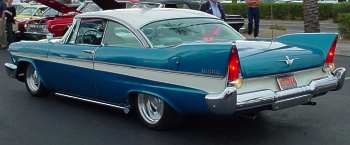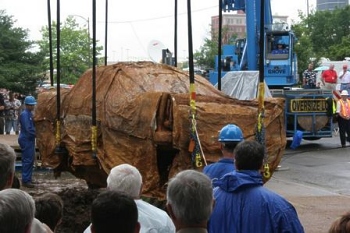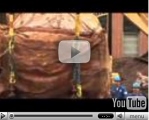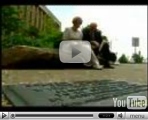
Automotive Intelligence - the web for automotive professionals and car enthusiasts
June 20, 2007
This Week:
-
50 Years Later the “Buried Car”, a 1957 Plymouth Belvedere, is unveiled in Tulsa, Oklahoma
-
MINI United 2007: MINI Fans will meet in Zandvoort near Amsterdam, NL, for a Three Day Festival
-
European premiere of the Audi Cross Coupé quattro study at The Design Annual in Frankfurt
-
Relearn to Drive: BMW’s Performance Driving School aims at safer driving
-
2007 DARPA Urban Challenge in the US: Volkswagen to enter sensor-driven Passat
-
DaimlerChrysler Truck Group enters Strategic Cooperation with Fiat Powertrain Technologies
-
American Honda Opens New Midwestern Consolidation Center in Troy, Ohio
-
GM To Invest $100 Million In New York Plant For Diesel Engine Production
-
Mercedes’ Dr. Rodolfo Schöneburg receives U.S. Government Award for Safety Engineering Excellence
© 1998 - 2007 Copyright
&
Disclaimer
Automotive Intelligence,
www.autointell.com
All Rights Reserved .
For questions please contact
editor@autointell.net
|
50 Years Later the “Buried Car”, a 1957 Plymouth Belvedere, is unveiled in Tulsa, Oklahoma “Suddenly it’s 1960!” That’s what the magazine ads proclaimed 50 years ago in announcing the all-new 1957 Plymouth. With its new highly-acclaimed Torsion-Aire front suspension, push-button Torqueflite automatic transmission and soaring tail fins, the 1957 Plymouth was advertised as “Three Full Years Ahead” of its competition in the low-priced field — “the only car to break the time barrier.”
Now, suddenly it’s 2007, and the 1957 Plymouth re-emerged as part of TULSARAMA, the City of Tulsa’s celebration of the 100th anniversary of Oklahoma statehood.
|
|
|
|
On Friday, June 15, the city unearthed a 1957 Plymouth Belvedere buried in a time capsule in front of the county courthouse in downtown Tulsa 50 years ago. The vehicle will belong to the person (or heir) who in 1957 came closest to guessing the city’s population in 2007. When the capsule was opened it could be seen, that the car was under water up to the windows. Once the water was pumped out and the car manoeuvred onto a transport, it became clear, that the old Plymouth might have taken damage from the water. Finally once the plastic seal was taken of, a sad picture of a totally rotten wrack came into sight. |
The next opportunity to see a Plymouth emerge from the ground in Tulsa will be in 2037, when the city will unearth a 1997 Prowler buried in Centennial Park as part of a celebration of the city's founding. Hopefully 2007’s technology will provide a more substantial cover.


The car is totally rotten
The revolutionary design of the 1957 Belvedere was appropriate for the Tulsa time capsule: Oklahoma Golden Jubilee chairman W.A. Anderson declared the finned Plymouth had “the kind of lasting appeal that should be in style 50 years from now.”
This revolutionary Plymouth was the work of the styling team assembled in the early 1950s by famed designer Virgil Exner, notes Chrysler senior designer and design historian Jeffrey Godshall.
Hired from Studebaker in 1949, Exner first explored new directions in styling through a series of concept cars — or as Exner called them, “idea cars." This tradition of concept cars continues with today’s Chrysler.

Even Fuel and Oil was added to the "Time Capsule"
After a spate of innovative “idea cars” such as the 1951 Chrysler K310 and the 1953 Chrysler d’Elegance, Exner was given responsibility for the styling of the company’s production cars. His first advanced designs in 1955 — referred to as The Forward Look — were followed by the “Flight Sweep” cars of 1956, marking the first time an automobile manufacturer applied fins to its entire line of vehicles.
With even larger towering fins, the ’57 Plymouth was a stunner, Godshall said.
The extreme lowness of the car, its light-looking roof supported by thin pillars and the big fins gave the exciting new Plymouth the wedge-shaped silhouette that Exner and his staff were looking for — the same shape used in military aircraft, Gold Cup racing boats and ballistic missiles.

The Plymouth Belvedere
And the fins were functional as well. Contemporary wind tunnel testing proved they reduced the need for steering corrections in strong crosswinds.
The new ‘57s were enthusiastically embraced by a buying public who saw the big fins as a symbol of a future of carefree living, Godshall said. The combination of advanced styling, Torsion-Aire ride and Torqueflite transmission enabled Plymouth to recapture its status among the leaders in auto industry sales.
Photos: Tulsa Archives, Bryan Campbell/Tulsarama
(June 15, 2007)
| .
Homepage News Companies Management Publications Events Guestbook Search . |



